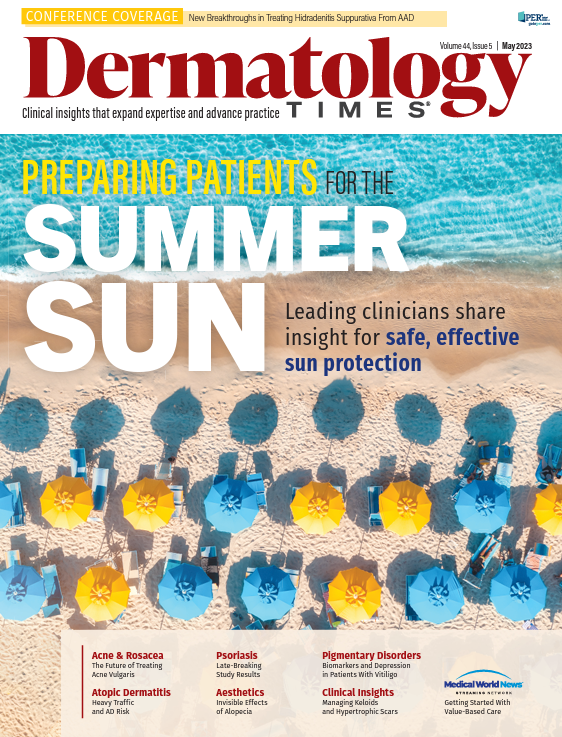- Case-Based Roundtable
- General Dermatology
- Eczema
- Chronic Hand Eczema
- Alopecia
- Aesthetics
- Vitiligo
- COVID-19
- Actinic Keratosis
- Precision Medicine and Biologics
- Rare Disease
- Wound Care
- Rosacea
- Psoriasis
- Psoriatic Arthritis
- Atopic Dermatitis
- Melasma
- NP and PA
- Skin Cancer
- Hidradenitis Suppurativa
- Drug Watch
- Pigmentary Disorders
- Acne
- Pediatric Dermatology
- Practice Management
- Prurigo Nodularis
- Buy-and-Bill
Publication
Article
Dermatology Times
Narrow-Spectrum Antibiotics: The Precision Medicine of Acne?
Author(s):
“The present and future is narrow-spectrum antibiotics because they enhance antibiotic stewardship, they protect the host microbiome, [and] they reduce antibiotic resistance,” AAD 2023 presenter Christopher Bunick, MD, PhD, said.
Dermatologists write around 7 million antibiotic prescriptions per year, according to 2016 data1, with the highest rate per clinician than any other physician group. Clinicians are turning to oral antibiotic options both as first-line therapy and alternative treatment for a variety of chronic inflammatory skin disorders, including moderate and severe acne vulgaris. Because of this, it is imperative that dermatologists fully understand how to use antibiotics responsibly.
Christopher Bunick, MD, PhD

Christopher Bunick, MD, PhD, associate professor of dermatology at Yale School of Medicine, delivered a talk on using oral antibiotics for acne vulgaris during the “Acne Boot Camp” session at the American Academy of Dermatology (AAD) 2023 Annual Meeting, held March 17-21, in New Orleans, Louisiana.2 In his lecture, Bunick reviewed appropriate use of antibiotics, detailed the mechanisms of resistance, and unveiled exactly why targeted, narrow-spectrum antibiotics are a better choice to limit resistance.
“Would it surprise you if I told you that for the last 50 years, we've been prescribing these antibiotics trying to target Cutibacterium acnes without actually knowing how those antibiotics work on C anes?” Bunick asked the audience. “And what if I told you [that] at the end of this talk I'm going to show you the breakthrough research of why that's no longer the case?”
Tetracyclines made up the majority (73.4%) of dermatologists’ antibiotic use between 2014 and 2016, likely because of the dual anti-inflammatory and antibacterial properties, Bunick said. The tetracycline class of antibiotics work to suppress the pro-inflammatory cytokine release; inhibit lipases and neutrophil migration, effectively reducing tissue destruction; inhibit nitric oxide synthase expression; reduce mast cell activation; and inhibit T-lymphocyte activation and proliferation, among other things.
Tetracyclines rely on a DCBA naphthacene core, which serves as the structural building block, and they work by binding to the 30S subunit of the bacterial ribosome. While first- and second-generation tetracyclines like doxycycline and minocycline have broad-spectrum activity and may often be used for empirical treatment, third-generation tetracyclines like sarecycline are much more narrow in scope and used to target specific causative pathogens such as C acnes. They also don’t contribute to gut dysbiosis the way broader agents do.
“If someone tells you the antibiotics do not have a place in dermatology, I just don't believe that is true,” Bunick said. “It is my personal opinion [that] we write so [many prescriptions for] tetracycline antibiotics and doxycycline that it is essential that dermatologists know tetracycline antibiotics for the safety of our patients, for the health of our patients, and so that we can be competent physicians.”
Antibiotic stewardship has also played a part in advancing the tetracycline class of antibiotics, as the US Centers for Disease Control and Prevention advises selecting narrow-spectrum drugs whenever possible.
The goal, of course, is to prevent antibiotic resistance, which is problematic not just for the current generation but for generations to come, and narrow-spectrum tetracyclines are uniquely positioned to help overcome it.
Sarecycline, in particular, inhibits 2 active centers of the C acnes 70S ribosome, Bunick said—something his lab discovered while studying the C acnes ribosome via cryoelectron microscopy.
“We now know that this narrow-spectrum, this new precision medicine in acne blocks 2 active centers in the C acnes ribosome,” Bunick said. “This is very profound because it means, or at least it explains partly, why we have this narrow-spectrum agent that might give us a real step forward or advancement in practicing antibiotic stewardship in dermatology.”
References:
- Grada A, Armstrong A, Bunick C, Salem R, Feldman S. Trends in Oral Antibiotic Use for Acne Treatment: A Retrospective, Population-Based Study in the United States, 2014 to 2016. J Drugs Dermatol. 2023 Mar 1;22(3):265-270. doi: 10.36849/JDD.7345. PMID: 36877883.
- Bunick C. Oral antibiotics for acne vulgaris: Improving antibiotic stewardship through science. Presented at American Academy of Dermatology 2023 Annual Meeting; March 17-21, 2023; New Orleans, LA.







